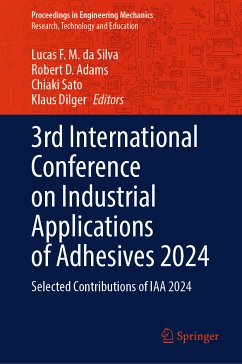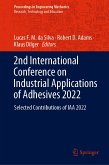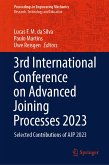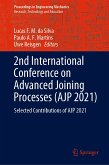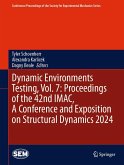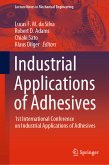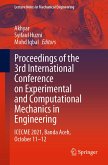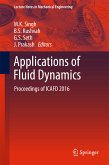3rd International Conference on Industrial Applications of Adhesives 2024 (eBook, PDF)
Selected Contributions of IAA 2024
Redaktion: Da Silva, Lucas F. M.; Dilger, Klaus; Sato, Chiaki; Adams, Robert D.


Alle Infos zum eBook verschenken

3rd International Conference on Industrial Applications of Adhesives 2024 (eBook, PDF)
Selected Contributions of IAA 2024
Redaktion: Da Silva, Lucas F. M.; Dilger, Klaus; Sato, Chiaki; Adams, Robert D.
- Format: PDF
- Merkliste
- Auf die Merkliste
- Bewerten Bewerten
- Teilen
- Produkt teilen
- Produkterinnerung
- Produkterinnerung

Hier können Sie sich einloggen

Bitte loggen Sie sich zunächst in Ihr Kundenkonto ein oder registrieren Sie sich bei bücher.de, um das eBook-Abo tolino select nutzen zu können.
This book offers selected papers presented at the 3rd International Conference on Industrial Applications of Adhesives, held in Cascais, Portugal, March 7-8, 2024. The goal of the conference was to provide a unique opportunity to exchange information, present the latest results as well as to discuss issues relevant to industrial applications of adhesives. Special contributions on formulation of adhesives, pressure sensitive adhesives, adhesive properties, design of adhesive joints, and durability of adhesive joints have been selected for this volume. This work will appeal to a wide readership,…mehr
- Geräte: PC
- ohne Kopierschutz
- eBook Hilfe
- Größe: 7.67MB
![2nd International Conference on Industrial Applications of Adhesives 2022 (eBook, PDF) 2nd International Conference on Industrial Applications of Adhesives 2022 (eBook, PDF)]() 2nd International Conference on Industrial Applications of Adhesives 2022 (eBook, PDF)161,95 €
2nd International Conference on Industrial Applications of Adhesives 2022 (eBook, PDF)161,95 €![3rd International Conference on Advanced Joining Processes 2023 (eBook, PDF) 3rd International Conference on Advanced Joining Processes 2023 (eBook, PDF)]() 3rd International Conference on Advanced Joining Processes 2023 (eBook, PDF)153,95 €
3rd International Conference on Advanced Joining Processes 2023 (eBook, PDF)153,95 €![2nd International Conference on Advanced Joining Processes (AJP 2021) (eBook, PDF) 2nd International Conference on Advanced Joining Processes (AJP 2021) (eBook, PDF)]() 2nd International Conference on Advanced Joining Processes (AJP 2021) (eBook, PDF)129,95 €
2nd International Conference on Advanced Joining Processes (AJP 2021) (eBook, PDF)129,95 €![Dynamic Environments Testing, Vol. 7: Proceedings of the 42nd IMAC, A Conference and Exposition on Structural Dynamics 2024 (eBook, PDF) Dynamic Environments Testing, Vol. 7: Proceedings of the 42nd IMAC, A Conference and Exposition on Structural Dynamics 2024 (eBook, PDF)]() Dynamic Environments Testing, Vol. 7: Proceedings of the 42nd IMAC, A Conference and Exposition on Structural Dynamics 2024 (eBook, PDF)161,95 €
Dynamic Environments Testing, Vol. 7: Proceedings of the 42nd IMAC, A Conference and Exposition on Structural Dynamics 2024 (eBook, PDF)161,95 €![Industrial Applications of Adhesives (eBook, PDF) Industrial Applications of Adhesives (eBook, PDF)]() Industrial Applications of Adhesives (eBook, PDF)81,95 €
Industrial Applications of Adhesives (eBook, PDF)81,95 €![Proceedings of the 3rd International Conference on Experimental and Computational Mechanics in Engineering (eBook, PDF) Proceedings of the 3rd International Conference on Experimental and Computational Mechanics in Engineering (eBook, PDF)]() Proceedings of the 3rd International Conference on Experimental and Computational Mechanics in Engineering (eBook, PDF)113,95 €
Proceedings of the 3rd International Conference on Experimental and Computational Mechanics in Engineering (eBook, PDF)113,95 €![Applications of Fluid Dynamics (eBook, PDF) Applications of Fluid Dynamics (eBook, PDF)]() Applications of Fluid Dynamics (eBook, PDF)233,95 €
Applications of Fluid Dynamics (eBook, PDF)233,95 €-
-
-
Dieser Download kann aus rechtlichen Gründen nur mit Rechnungsadresse in A, B, BG, CY, CZ, D, DK, EW, E, FIN, F, GR, HR, H, IRL, I, LT, L, LR, M, NL, PL, P, R, S, SLO, SK ausgeliefert werden.
- Produktdetails
- Verlag: Springer International Publishing
- Seitenzahl: 127
- Erscheinungstermin: 16. September 2024
- Englisch
- ISBN-13: 9783031695032
- Artikelnr.: 71748235
- Verlag: Springer International Publishing
- Seitenzahl: 127
- Erscheinungstermin: 16. September 2024
- Englisch
- ISBN-13: 9783031695032
- Artikelnr.: 71748235
- Herstellerkennzeichnung Die Herstellerinformationen sind derzeit nicht verfügbar.
Adhesive Joints in Carbon-Epoxy Composites for Mode I and II Fracture.
Adhesive Joints in Carbon-Epoxy Composites for Mode I and II Fracture.
